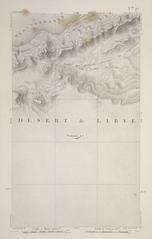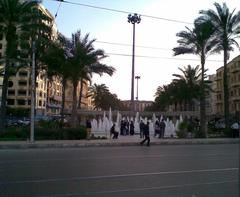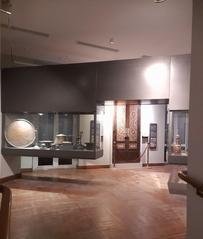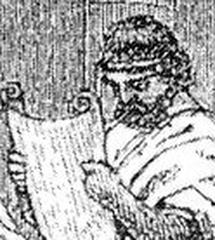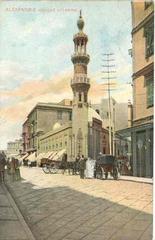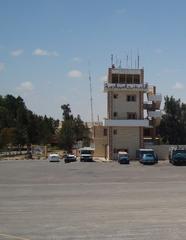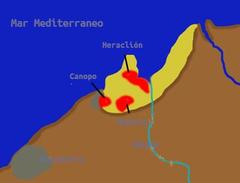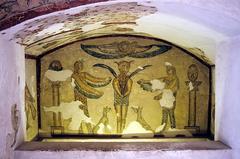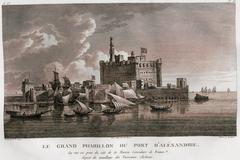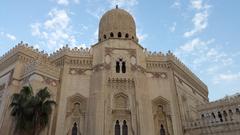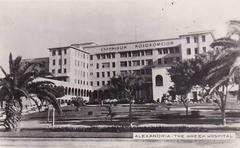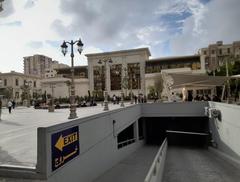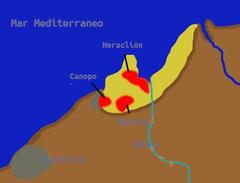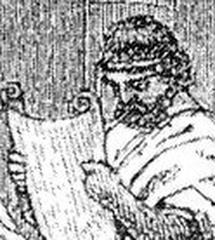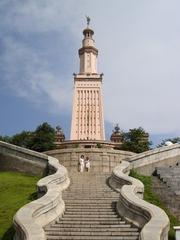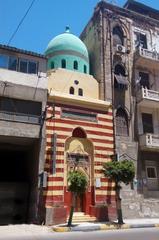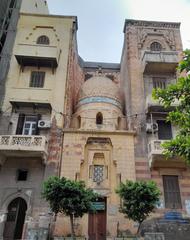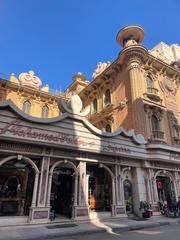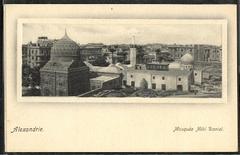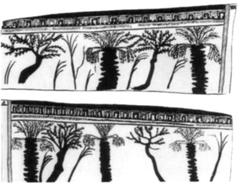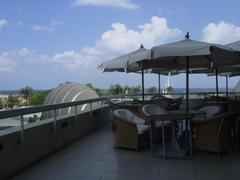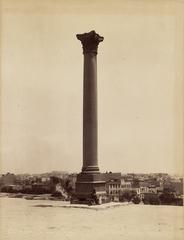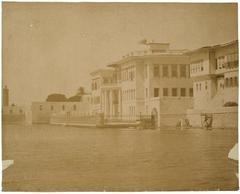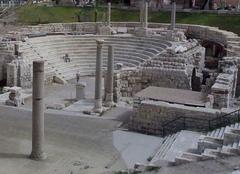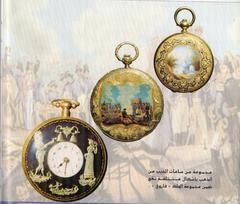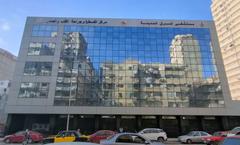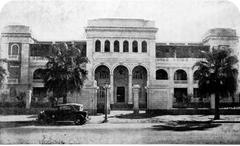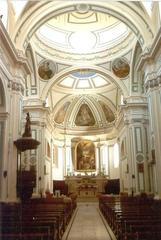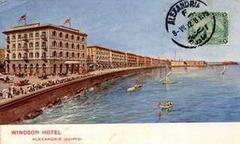Al Mouwasat Mosque Alexandria: Visiting Hours, Tickets, and Historical Significance
Date: 14/06/2025
Introduction
Set in the heart of Alexandria’s Anfushi district, Al Mouwasat Mosque is a cornerstone of the city’s Islamic heritage. While often overshadowed by more famous mosques, it offers an immersive blend of spiritual tranquility, artistic architecture, and vibrant community life. This article explores the mosque’s origins, architectural evolution, religious significance, and provides essential visitor information—including visiting hours, ticketing, accessibility, etiquette, and nearby attractions. Whether you are a history enthusiast, spiritual pilgrim, or traveler, this guide will help you make the most of your visit.
Table of Contents
- Introduction
- Historical Background
- Religious Significance
- Architectural Features
- Preservation and Restoration
- Visitor Information
- FAQ
- Conclusion
- Sources
Historical Background
Origins and Early Development
Al Mouwasat Mosque was established during the transformative period following the Arab conquest of Egypt in the 7th century CE (Memphis Tours). Its name, meaning “consolation” or “compassion,” reflects its foundational role as both a place of worship and a center for social welfare. The construction of mosques like Al Mouwasat was pivotal as Alexandria transitioned into an important Islamic urban center, integrating religious, social, and educational functions.
Architectural Evolution
The mosque’s architecture blends traditional Islamic motifs with local Alexandrian influences. Over centuries, it has drawn on design elements from various Islamic dynasties. Its façade features intricate stonework and geometric patterns, while the prayer hall displays impressive calligraphy and arabesque decorations. The layout, with a central courtyard and expansive prayer area, is typical of Egyptian mosque architecture, supporting both congregational worship and communal gatherings (Egypt Tours Plus).
The Mosque’s Role in Alexandria’s Islamic Heritage
Al Mouwasat Mosque is part of a network of historic mosques—including the nearby Al-Mursi Abu Al-Abbas and Al-Imam Al-Busiry mosques—that collectively narrate Alexandria’s Islamic legacy (Travel2Egypt). Through the medieval and Ottoman periods, these mosques served not just religious roles but also social and educational purposes, anchoring community life and providing charitable aid.
Religious Significance
Spiritual and Social Importance
As a center for daily prayers, Friday congregations, and major Islamic celebrations, Al Mouwasat Mosque is vital to Alexandria’s Muslim community. Its ethos of compassion is evident in ongoing charitable activities, such as food distribution and support for the needy—a tradition deeply rooted in Islamic teachings.
Educational Functions
Historically, the mosque served as a center for religious education, with scholars offering instruction in Islamic jurisprudence, theology, and language. Today, it continues to host classes, lectures, and study circles, supporting the preservation and dissemination of Islamic knowledge (Islamic Landmarks).
Symbolism and Community Role
The mosque symbolizes unity and resilience for Alexandria’s diverse population. By welcoming people from various backgrounds and participating in interfaith and community events, it strengthens social cohesion in the city (Top Ten Egypt).
Pilgrimage and Religious Tourism
While not a major pilgrimage site, Al Mouwasat Mosque attracts visitors from across Egypt and beyond, especially during religious festivals. Its reputation for hospitality and spiritual ambiance makes it a favored destination for those seeking both solace and insight into Alexandria’s Islamic traditions.
Preservation of Traditions
Through its rituals, ceremonies, and educational outreach, the mosque helps preserve Alexandria’s religious traditions, ensuring their relevance for future generations.
Architectural Features
Exterior Design and Layout
The mosque’s architecture harmonizes Islamic and Egyptian styles, highlighted by a central dome, smaller subsidiary domes, and a prominent minaret. The exterior is clad in cream-hued stone with arabesque carvings, and the building’s footprint centers on a spacious courtyard (sahn) with arcaded walkways and a ritual fountain (Africame).
Minaret and Domes
The slender minaret—typical of Ottoman or Mamluk style—serves as both a visual landmark and the locus for the call to prayer. Domes are elaborately decorated, with geometric patterns and Quranic inscriptions accentuating the structure’s spiritual significance.
Interior Ornamentation
The main prayer hall features rows of marble or granite columns, a richly adorned mihrab, and a finely crafted minbar. The walls and ceilings are decorated with arabesque motifs, calligraphy, and intricate muqarnas, exemplifying Egyptian Islamic decorative arts (Hurghada Lovers). Women’s prayer spaces are typically on mezzanines, separated by ornate screens.
Materials and Construction
Locally quarried limestone and marble provide the mosque’s structural backbone, while imported granite and woodwork add elegance and durability. Stained glass windows and carved doors enhance the building’s visual richness (Egypt Tours Plus).
Urban Context
Al Mouwasat Mosque anchors a bustling plaza in Alexandria’s Anfushi district, surrounded by markets, shops, and public spaces. The mosque’s integration with its urban setting underscores its role as a religious, social, and cultural hub (Omrania).
Preservation and Restoration
Preservation initiatives have focused on stabilizing the mosque’s structure, restoring decorative elements, and improving facilities—balancing historical authenticity with the needs of a living religious space (Arab Contractors). Conservationists address challenges from humidity, salt, and urban encroachment, while community engagement ensures the mosque’s continued vitality (Luxor International Journal of Archaeological Studies).
Visitor Information
Visiting Hours and Tickets
- Hours: Generally open daily from 8:00 AM to 6:00 PM; hours may be extended during Ramadan or special religious events.
- Tickets: Entry is free for worshippers; tourists may pay a nominal fee (usually around 20 EGP) to support preservation. Donations are always welcomed.
Accessibility
The mosque is accessible by taxi, ride-sharing, or public transport from central Alexandria. Ramps and designated areas are available for visitors with mobility challenges, although some historic sections may be less accessible.
Guided Tours and Experiences
Guided tours can be arranged via local agencies or the mosque administration, with options in Arabic and English. These tours offer deeper insights into the mosque’s history, architecture, and religious significance.
Etiquette and Dress Code
- Dress modestly: Women should cover their hair and wear long sleeves and ankle-length skirts or trousers; men should wear long trousers and shirts with sleeves.
- Remove shoes before entering prayer areas; a small tip for the shoe attendant (EGP 1–5) is customary.
- Photography: Allowed in most areas, but always seek permission before photographing worshippers or ceremonies, and avoid using flash.
- Respect prayer times: Avoid walking in front of worshippers and maintain a quiet demeanor.
Nearby Attractions
- Abu al-Abbas al-Mursi Mosque
- Citadel of Qaitbay (0.6 miles)
- Ras El Tin Palace (0.7 miles)
- Catacombs of Kom El Shoqafa
- Bibliotheca Alexandrina
- Historic shipyards, traditional markets, and local cafés
(Lonely Planet; egiptoexclusivo.com)
Frequently Asked Questions (FAQ)
Q: What are the mosque’s visiting hours?
A: Typically 8:00 AM–6:00 PM daily; hours may extend during Ramadan.
Q: Is there an entrance fee?
A: Entry is free for worshippers; tourists may pay a small fee (approx. 20 EGP).
Q: Are guided tours available?
A: Yes, in multiple languages via local agencies or the mosque administration.
Q: Is the mosque accessible for people with disabilities?
A: Most public areas are accessible, but some historic sections have steps.
Q: What should I wear?
A: Modest attire—head covering for women, long sleeves and trousers or skirts, clean socks, no shorts or sleeveless tops.
Q: Can non-Muslims visit?
A: Yes, outside prayer times; visitors should observe etiquette and dress codes.
Conclusion
Al Mouwasat Mosque is far more than an architectural gem—it is a living institution at the heart of Alexandria’s Islamic and urban heritage. Its centuries-old role in fostering religious devotion, education, and community welfare continues, thanks to ongoing preservation and the active participation of locals and visitors alike. By respecting visiting hours, dress codes, and mosque etiquette, you can experience both the spiritual serenity and the vibrant cultural legacy that define this remarkable site.
To enrich your visit, consider exploring nearby historical attractions and immersing yourself in Alexandria’s diverse heritage. Download the Audiala app for curated tours, real-time updates on mosque hours, and insider tips for an authentic experience.
